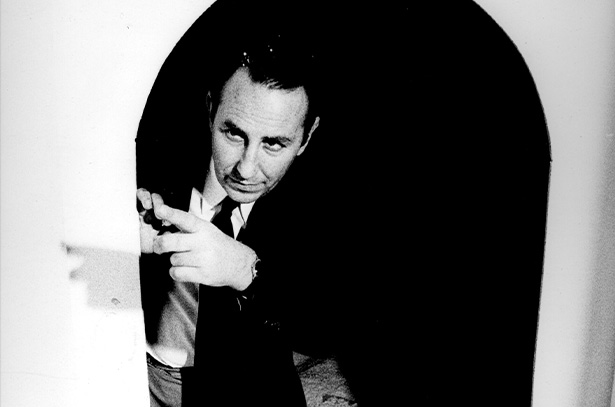Beginning 5 March 2015, Hauser & Wirth will present the first major New York exhibition devoted to renowned postwar Italian avant-garde artist Fabio Mauri. In a career spanning five decades and a diversity of disciplines and mediums, ranging from drawing, painting, sculpture, performance, film, and installation, to the theatre and theoretical writings that reflect upon the world at large, Fabio Mauri expressed through his art an unyielding critical exploration into the power of ideology and language associated with the Second World War, the rise of Fascism, and the Holocaust, and their lingering echoes in the modern world. His work recovers historical memory that is both individual and collective. Sobering, direct, and poetically reflective, Mauri's art addresses themes of communication and manipulation, and brings light to the 'political dimension of the image' as it is projected and proliferates throughout contemporary society.
Organized with Olivier Renaud-Clément, 'Fabio Mauri. I was not new' will remain on view at Hauser & Wirth's East 69th Street location through 2 May 2015, and will be accompanied by a publication.
A compact survey of works by Fabio Mauri will be a highlight of the upcoming La Biennale di Venezia – 56th International Art Exhibition, curated by Okwui Enwezor. The Biennale will be on view 9 May through 22 November 2015.
The exhibition takes its title from a text written by the artist and displayed as part of the installation 'Quadreria' (Picture Gallery) (1999), which summarizes the fates of his relatives, including his great-grandfather Roberto Bompiani, a prominent artist in his time. Presenting an overview of Mauri's vast and complex oeuvre, highlights of the show include examples of his first monochromatic Schermi (Screens) from the 1950s and 1960s; a recreation of the artist's first environmental installation 'Luna' (Moon) (1968); objects from the performances 'Dramophone' (1976) and 'Ebrea' (Jewess) (1971); as well as a selection of projections and installations, including 'Rebibbia' (2006) and 'Quadreria' (1999). Also on view will be an installation of colossal perforated doormats that were created within the last year of the artist's life. Presented in Kassel at dOCUMENTA (13), each work is inscribed with various phrases, such as 'Art is important because it represents history and the world as a whole' (2009) and 'Art is not autonomous' (2009).
'I was not new' at Hauser & Wirth follows the highly-acclaimed retrospective exhibition presented at Fundacion PROA, Buenos Aires, Argentina (2014) and marks the momentous occasion of Fabio Mauri's first ever solo exhibition in New York.
Performance
On 24 March, Hauser & Wirth will re-stage the historical performance 'Ebrea', one of Mauri's most provocative and celebrated works. A hauntingly powerful presentation, the performance touches upon topics of ethnic and racial intolerance, unwavering themes that course throughout Mauri's work. Re-performed countless times during the artist's life, 'Ebrea' was first presented in October 1971 at Galleria Barozzi in Venice. Mauri's work has been included in five previous editions of the Venice Biennale in 1954, 1974, 1978, 1993 and 2013, and was recently exhibited at dOCUMENTA (13) in 2012.
About the Artist
Fabio Mauri was born in Rome in 1926. His early youth was marked by the events of war and Fascism – traumas and horrors that would profoundly impact and influence the artist's life and work. His parents were giants of Italy's publishing industry. Mauri's grandfather, Valentino Bompiani, founded one of country's most prestigious publishing houses, which played a crucial role in the development of twentieth century Italian literature. Raised among writers and painters, it was natural that Mauri would befriend intellectuals in both artistic and cultural circles of Italy's new avant-garde, among them: the novelist Italo Calvino, philosopher and semiotician Umberto Eco, film director and aficionado Pier Paolo Pasolini (the artist's close childhood friend), visual artist Jannis Kounellis, art historian Maurizio Calvesi and the writer Edoardo Sanguineti.
First emerging in the late-fifties, Fabio Mauri (1926 – 2009) developed the ideas for his work in the context of television and cinema, which from 1954 became a part of everyday cultural life. The projected image and the screen were central motifs that defined his oeuvre. Connecting themes and ideas of the past to the present, his work injects within itself a notion of ethical or social responsibility that causes the spectator to critically examine his experience of 'the real'. Mauri's artistic career remains as varied and diverse as the activities in which he engaged. For nearly two decades, he worked for the publisher Bompiani, from 1957 to 1975, directing its headquarters in Milan and Rome. Along with Umberto Eco and Edoardo Sanguineti, he founded the magazine 'Quindici' (1967) and the magazine for arts criticism, 'La citta di Riga' in 1976. An artist, playwright, publisher, critic and professor for over twenty years, Fabio Mauri's wide-ranging oeuvre cannot be easily defined. Highly innovative and active in Italy's avant-garde, much of his work, however, remained on the periphery of the parallel artistic movements of the time, such as Arte Povera and Pop Art.























